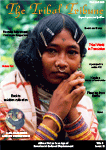Nature Talk
Development of living condition of tribal people is a much-discussed topic today. The motto that every citizen of any welfare nation enjoys right to a minimum standard of living, made the government to churn out various plans for development. Planners earmark target population of different categories according to their state of under development. There are very primitive communities, some intermediate type and others who are steadily progressing. Their habitats also vary from dense forest to villages with cultivable land. So single planning for development for all types of tribal communities would not be suitable.
Government plans with much elaboration and the matter of development involves various developmental programmes by the government. There occur contradictions, which make implementation ineffective. For example, the restoration of right to forest land for the tribal people conflicts with the interest of the people whose villages fall in the Reserve Forest Areas. The amended Forest Right Act, The Wild Life Protection Act and the National Tiger Conservation Declaration are at places conflict with each other and stand against unfettered development of tribal people. So is the matter of eviction and resettlement process. It creates conflict between the revenue department and Gram Sabha, an elected body of affected villagers. Lack of coordination spoils all good intentions of plans.
More grave is the situation of vanishing tribal communities of Andaman and Nicobar islands. Extremely endangered the Great Andamanees and the Onges are saved from total extinction by converting them as dole dependent communities. Vices of imposed development took lives of a group of Onges in 2008 through spurious liquor. Another primitive group, the Jarawas has become victims of aggressive intrusion of advanced people due to construction of Andaman Trunk Road through their secluded habitat. Government has prepared a master plan to stop further damage from outsiders. In reality little is done.
In the context of the planning for tribal development, it may be relevant to remember the ideas of Rabindranath Tagore on his 150th birth anniversary. One hundred years ago he initiated a development process in a scientific manner with own resources. According to him the backwardness of the tribal people is due to their hopelessness and loss of zeal to improve. Prolonged dependence on the wealthy lords made them imitating others and losing self-reliance. He prescribed resurrection of inner spirit and belief in their own capabilities. Contrary to monetary help and subsidy or free aids, Rabindranath took practical steps for selected geographical areas and succeeded tremendously. There was no gap between plan and execution, as observed today. Tagore discarded the imposed development conceived by advanced people in their own standard. Planning for development of very primitive, backward, and advanced tribal communities can only be effectively designed if viewed with empathy and executing machinery is truly dedicated.



